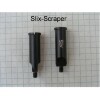Myth to some/real to others
It's easy enough to prove, what your looking at is the ability of the case to be able to expand enough to release the bullet. The smaller the window of expansion, the more the short start pressure of the load increases.
Take a .358" bullet and load up 6 rounds using a powder like ww-231, unique, AA#5,etc. Nothing hot & use a load that's in the middle of the reloading data. Take the same bullet but size them to .360"/.361" and use the same load. Go out & do some testing you'll find out real fast if it's fact or fiction.
I swage my own jacketed 44cal bullets. I make them .430" for a s&w 629 and ..432" for a contender. Was doing test loads with both firearms during the same range session. Had the same loads just different diameter bullets for each firearm. At the end of the session I had several sighter/bbl fouling rounds for the contender left. I like shoot a couple fouling shots in a clean bbl then test loads. Anyway I put a cylinder full of those mild/middle of the road fouling rounds with the .432" bullets in the s&w 629.
They all went bang, nothing odd like extremely loud noises/flash/etc. It got interesting when I tried to eject the cases, had to pound them out with a hammer and brass rod. They blammo ammo/fouling loads were 1 1/2gr less then the loads I just tested with the .430" bullets. Those hotter loads with the .430" bullets had no problem ejecting. The .432" bullets with the lighter load did.
.432" bullet 8.0gr of universal
.430" bullet 9.5gr of universal
I was testing what the bullet would do expansion wise in a given velocity window. A 1100fps+/- impact was what I was testing. Mild loads @ 25yds do the same thing as hot loads that slow down @ 100yds, hence +/- 1100fps.

The home swaged bullets I was testing

Everything is a myth until you have to break out the hammer




